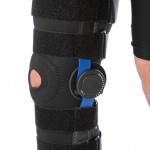
This weekend all the elves were having a family night around the campfire watching a re-run of the film Forest Gump and enjoyed the cinematic interpreation of Forest’s leg braces falling off as he started running away from bullies. You know the scene ‘Run Forest. Run’. As the conversation developed the elves asked the Musculoskeletal Elf what we knew about knee braces. Well thanks to our new elf blogger Lynne Rowley we know quite a lot.
Valgus knee braces are designed to redistribute the load on the inside area (medial compartment) of the knee. However there are variable recommendations in clinical guideleines about whether they should be used in clinical practice. This uncertainty about the clinical effects of valgus knee bracing and biomechanical mechanisms in patients with medial compartment osteoarthritis was examined in a new systematic review and meta-analysis.
Here’s what they did
The authors searched seven online databases up to May 2014 with no restrictions for study design or date. Two reviewers independently assessed abstracts and titles for studies investigating the biomechanical effects of wearing a valgus knee brace in the same group of patients. They inclued studies examining before and after wearing, with or without comparison with lateral wedged insole and a neutral knee brace. Studies were categorised into observational cohort/randomised control trials and laboratory studies. The authors assessed the quality of the studies and data analysis, including publication bias, standardised mean difference, heterogeneity and complications with brace use.
Here’s what they found
30 studies were included. These were categorised into 16 laboratory studies, 10 prospective cohort studies and four RCTs. Although blinding and concealment was low, no studies were excluded on the basis of quality. Data from 17 studies were combined in a meta-analysis
Frontal plane kinetics – overall statistically significant difference favouring the braced group for improvement in the knee adduction moment during walking. Four of the 17 studies also reported effects on sagittal plane with only one paper reporting changes in flexion and extension moments during stance when wearing a valgus brace.
Medial compartment joint space- Three studies used fluoroscopic gait analysis and found an average increase in medial compartment separation of 1.3mm-1.8mm with a reduction in pain. Two studies using standing AP radiographs found no difference.
Lower limb mal-alignment- 9 out of 11 studies reported a change in varus alignment from 0-2.6 degrees.
Muscle co-contraction- Two studies found decreased co-contraction ratios for vastus medialis/medial hamstrings, vastus lateralis/lateral hamstrings and vastus medialis/medial gastrocnemius and vastus lateralis/lateral gastrocnemius at different times of the gait cycle and using a neutral and 4° brace.
Proprioception- One study reported improvement in only joint repositioning test.
Direct measures of tibiofemoral contact force- Two in-vivo studies studies implanting sensors into the joint space reported contradictory results. One found significant reduction of forces when braced , the other reported no change between braced or unbraced but admitted results may be skewed by sensor implants moving.
Bone mineral density- One study reported increased bone mineral density in the medial and lateral tibial condyles after 3 months of brace use.
Dosage and frequency of brace use- 13 studies reported details of instructions provided to test subjects on the length of time the brace should be worn. Instructions varied from 30 mins to all day. Two studies indicated that a clinician should fit and provide instructions for the use of the brace but not frequency of use.
The authors concluded
Valgus knee braces can significantly alter knee biomechanics during walking through a combination of mechanisms.
…further studies are required to define the patient population that would most benefit from valgus bracing, investigate the optimal dosage, and evaluate the effects of bracing on disease progression and health economics.
The Musculoskeletal Elf’s view

Overall I found this to be a comprehensive analysis of the available evidence to date but have a few suggestions for future studies.
It was noted that the search terms did not include varus knee or medial compartment osteoarthritis/syndrome. Some braces correct forces on the knee but would not be categorised as a ‘valgus’ knee brace by Orthotists or other Bio-engineers as they are treating/correcting a varus knee and may never achieve a valgus alignment but may achieve considerable offloading and pain reduction.
It would have been useful to know which braces were compared in each study. There are several makes and construction of offloading knee braces available on the market with different characteristics and methods of altering angulation. Some use hinges to alter medio-lateral alignment which can be adjusted by the wearer, some have to be adjusted by the clinician. Some use straps rather than a frame to change forces on the limb. All of these factors could influence the results of the biomechanical effects of the braces on the knee.
Some studies identified problems with compliance and comfort. Compliance when using a brace is affected by comfort and that comfort is dependent on fit. It would be useful to look at whether the brace was measured and fitted by an appropriately trained clinician. It is possible that the compliance issues were related to brace selection, fit and or application of unintended forces to the body and not necessarily because of application of the intended forces.
What do you think?
- Are you an orthotist or bio-engineer who uses these braces regularly?
- Do you agree with these findings?
Send us your views on this blog and become part of the ever expanding Musculoskeletal Elf community. Post your comment below, or get in touch via social media (Facebook, Twitter, LinkedIn, Google+).
Links
- Moyer, R.F, Birmingham, T.B, Bryant, D.M, Giffin, J.R, Marriott, K.A, Leitch, K.M, 2015, “Biomechanical effects of valgus knee bracing: a systematic review and meta-analysis” Osteoarthritis Cartilage. Vol.23, no.2, pp.178-188, available from: http://www.ncbi.nlm.nih.gov/pubmed/25447975

Biomechanical Effects of Valgus Knee Braces http://t.co/87g77HUH8y
Wear a #kneebrace what are #biomechanical effects http://t.co/kbnXWv8OUW @NCOPEOP @SpecialtyBrace
#kneebrace what are #biomechanical effects? http://t.co/b3cnz0kfLV @360OandP @oandpedge @therealOPGA
Have #OA #knee wear a #kneebrace what are #biomechanical effects? http://t.co/kbnXWv8OUW @arthritis_ARC @ArthritisToday @Arthritis_care
RT @MSK_Elf: Have #OA #knee wear a #kneebrace what are #biomechanical effects? http://t.co/b3cnz0kfLV @arthritis_ARC @ArthritisToday @Arthr…
#OA #knee what are #biomechanical effects #kneebrace blog http://t.co/kbnXWv8OUW @AALOS
New blog #biomechanical effects of valgus #kneebraces http://t.co/kbnXWv8OUW @AmericanOandP